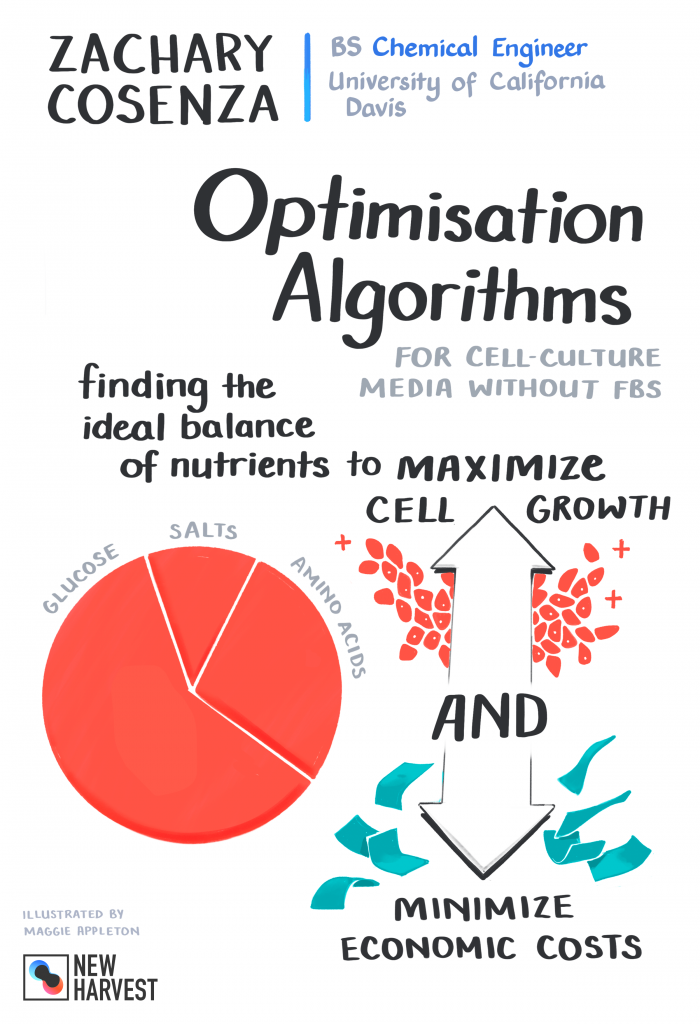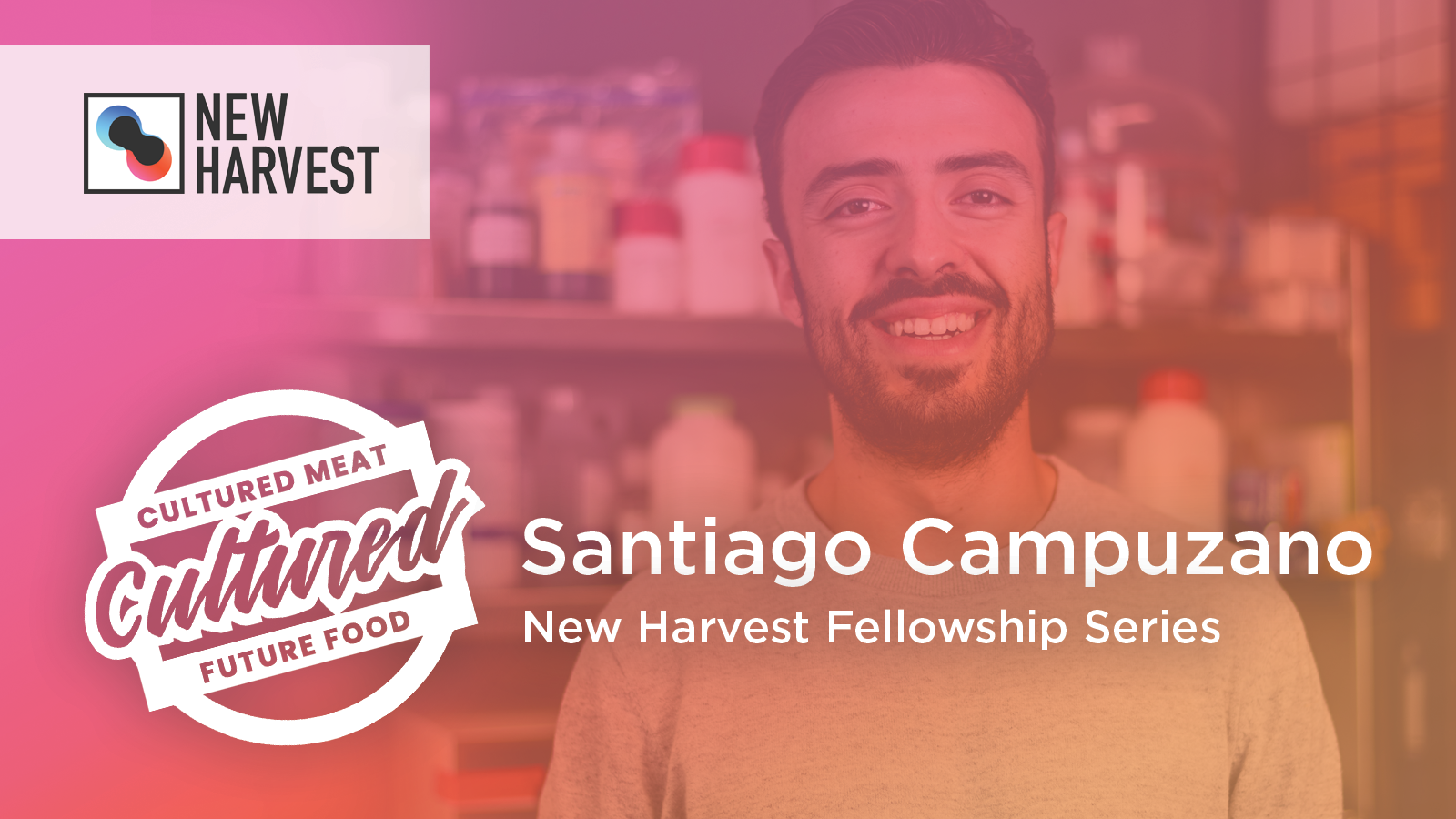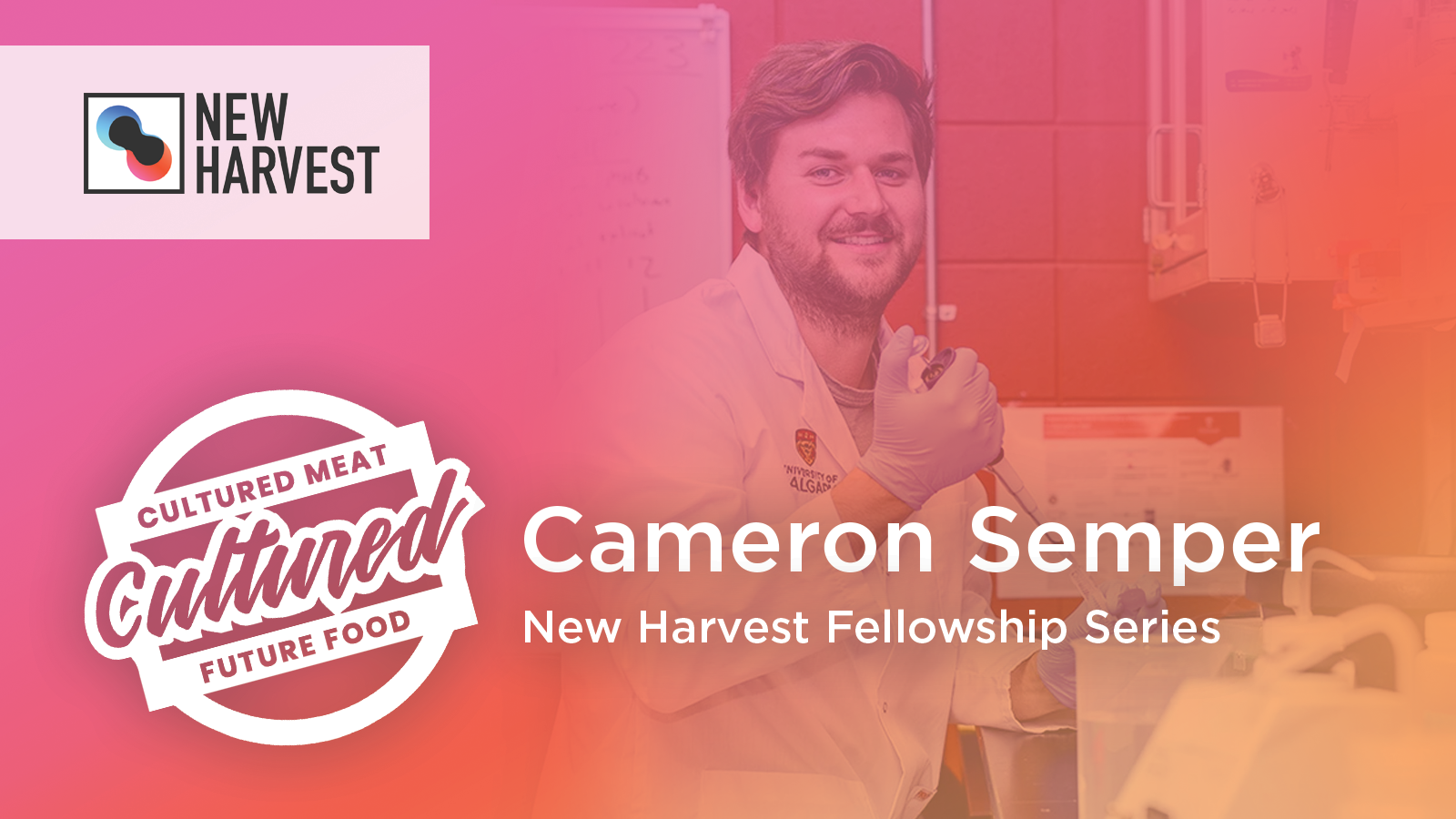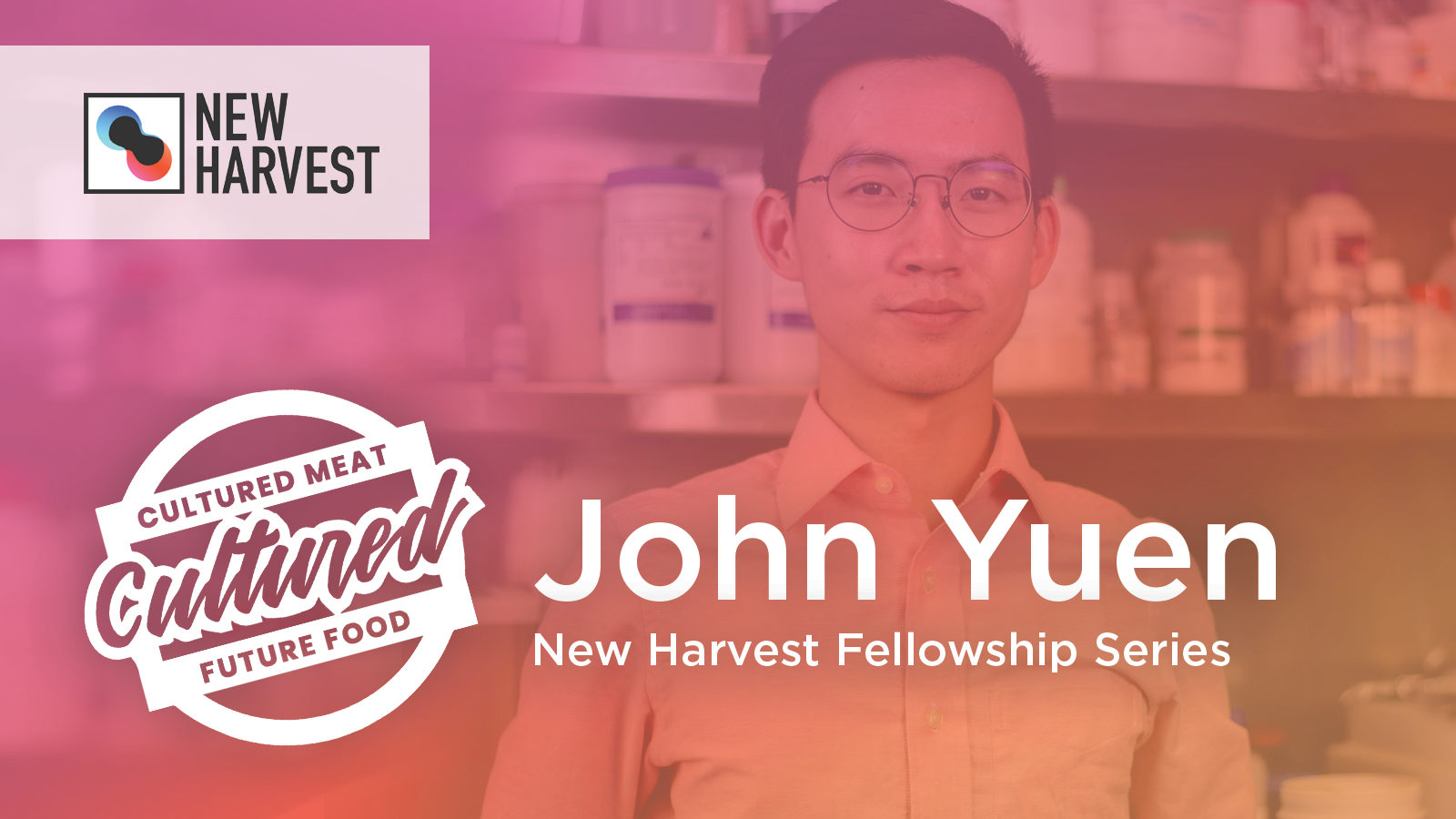Transcript
Also available on Spotify, Apple Podcasts, or wherever else you listen to podcasts!
Alex (00:04):
Thanks for joining us on the Cultured Meat and Future Food show. This episode is part of the New Harvest Fellowship series. We’re excited to have Zachary Cosenza as the guest for today’s show. Zac works on computational tools for design optimization and parameter estimation using optimal experimental design machine learning Bayesian optimization and other statistical learning methods all used for the design of cell growth media for bioprocesses and the cell-based meat industry. Let’s jump right in.
Alex (00:38):
Zac, welcome to the show!
Zac (00:39):
Hey Alex, thanks for having me.
Alex (00:41):
Zac, tell us a little bit about your research and what you’re currently working on.
Zac (00:45):
My research is currently working on methods for optimizing the media used in cultured meat products. As you’re aware, the media is one of the most expensive and difficult parts of cultured meat as a biological process. Cells need to grow in some sort of media containing the nutrients and growth factors that it requires. And one of the issues is that not only does it have FBS, or the fetal bovine serum that people are so concerned about, but we’re also dealing with often media that is undefined or poorly defined. So we don’t really know what’s in a lot of FBS products and a lot of other media that’s used in the academic level. So what I’m doing is I’m using various statistical methods to optimize the right concentrations of the different components in these media in order to achieve not only cell growth, but also an economical manufacturing method. So that’s what I do.
Alex (01:37):
Cool. And when we hear about FBS a lot, just like you mentioned and how that’s definitely a problem when it comes to scale, but when we say FBS is expensive, for example, how expensive is it?
Zac (01:49):
I don’t know the exact number and it depends on where you’re sourcing it from, but of the components I work with, FBS comprises of approximately 99.9% of the cost. So you can imagine all the little things, the amino acids and the glucose. But when all is said and done, FBS is pretty much the entire cost of the media.
Alex (02:10):
And that’s not even considering the animal welfare costs that’s associated with it as well.
Zac (02:15):
Absolutely.
Alex (02:16):
So we’ve heard of serum-free media that exists today, but is that just not good enough for cell cultured meat? And does that fall into the not defined category?
Zac (02:27):
Serum free media, it may be defined. It may not be defined. There are a lot of different definitions out there. Generally the serum-free media that is sold commercially to academics usually working in stem cells is not very efficient at growing cells. It either doesn’t grow them very quickly or it does so very expensively. So if you think that FBS is expensive, the growth factor combinations that are used to replace it are often much more expensive, so it’s completely uneconomical.
Alex (02:56):
Cool. And so you mentioned that you’re working on statistical methods to optimize different types of media that can be used and then explain it like I’m five type of way, what would be like a simplified version of how that works and the different puzzle pieces in there?
Zac (03:13):
Yeah, no problem. And that’s a good way of putting it. So the way I think about it is you have a bunch of inputs into a black box. The inputs being the concentrations of a bunch of different components, amino acids, glucose salts, et cetera, the outputs are what you want to maximize or minimize. So maybe you maximize cell proliferation and you want to minimize costs. And the black box is not understood very well. We don’t have good biological knowledge of what the relationship between every input and every output is. So what the statistical methods do is what I try to do is correlate those inputs to those outputs. And if your listeners remember maybe back from whatever statistical course, they may have had a linear regression where you fit a line to an input as it relates to an output, it could be something as simple as that. If we add more glucose, we end up with more cells. Of course, when you’re talking about multiple dimensions and when you’re talking about interactions between inputs and outputs and inputs and other inputs, it gets much more complicated. And that’s when you start to get into the more complicated areas of machine learning and Bayesian statistics and things like that.
Alex (04:20):
Wow, cool. So eventually some of these models that you’re putting together could pretty much tell us, you need X, you need, Y you need Z, and this is the perfect solution?
Zac (04:30):
Or approximately so yes.
Alex (04:31):
Right. Okay. Wow. That’s actually super exciting. So when did you actually first hear about cultured meat? When did you first hear about New Harvest?
Zac (04:39):
So I learned about cultured meat from my current PhD advisor, David Block. Who’s also at UC Davis with me. He suggested I work on this project for media optimization from the angle that I’m talking about because he worked on it previously for not cultured meat, but for, I would say yeast cells and other fermentations that they do in their department more often. And the way I found out about New Harvest was actually a funny story. My mom emailed me a link to New Harvest website for the Fellowship, and I ignored it for a while as you do with your parents unfortunately, sometimes. And I was looking for some funding when I came into UC Davis and I happened upon the email again. And I sent in our little package of information, things that we wanted to do, and they okay’d the grant, which was great. And we got another person, Ted O’Neill, who’s another person I work with. He did the same thing and he also got a grant. So we were very lucky there.
Alex (05:36):
Wow. That’s actually a really good story. When it comes to the university that you’re at UC Davis now, is that correct?
Zac (05:43):
Yes.
Alex (05:44):
UC Davis has been in the news about recent announcements related to cell cultured meat funding in general. Can you tell us a little bit about what those announcements were?
Zac (05:54):
Yeah, so we recently got a National Science Foundation grant. It’s sort of a convergence grant, which is meant to fund a research center. And a research center really is just a group of PhDs essentially. It’s not like a building or anything. Unfortunately we’re not there yet. This will be multiple students and multiple principal investigators working across various departments and food science, engineering, and biology addressing the various problems with cultured meat. So the one we’re focusing on in the chemical engineering department that I work with is the media optimization and determining the optimal concentration of various proteins and other content in media. So that’s only one part of this very large grant that we’ve gotten.
Alex (06:40):
Great. And so back to your research specifically, it’s definitely clear how it can benefit the future of cell cultured meat technology, but who specifically might it impact the most? Would it be researchers in this space? Who can really benefit from your research the most?
Zac (07:00):
Oh, good question. So I would say it’s very practical, industrial work that I’m doing right now. So I would say cell cultured meat companies that currently have a need for, let’s say scale up going from small amounts of cells to very large amounts of cells. They want to do it in an inexpensive way. And if you’re dealing with very large volumes, you’re dealing with exponentially increasing costs, this is what you would use for that. These algorithms that I’m working on.
Alex (07:27):
Would your models, get to the level where you’re creating optimizations for very large scale scenarios as well?
Zac (07:34):
Yeah, so the math actually doesn’t care what the labels are for all the data. So you could feed in whatever you want and it will try its best to do predictions. So if you could come up with a scientifically sound system that you believe you could model in a way that there’s not too much noise, or there’s not an incredible amount of bias, you can do experiments successfully, which is easier said than done. Then absolutely, the methods that I work on could be applied to virtually any system that could be optimized.
Alex (08:01):
You mentioned machine learning, the software side of me wants to learn more about the data inputs, how much data do you need? How much data do you have and really where are you getting the data right now?
Zac (08:13):
Yeah, that’s a great question because that’s one of the big problems when you’re actually working in the laboratory. It’s easy to have some compendium, some corpus (I think they use the word) of data that you pull from the internet, but I actually have to generate the data with my own hands. So we’re dealing with a very data limited environment. And one of the major pieces of my research and the people that work in my field is that we are working on algorithms and models that are meant to be applied to situations where you have very little data. So maybe less than a hundred or 150 data points. And maybe the data is noisy and complex and there are multiple dimensions to the data. So that’s one of the big issues and that’s one of the that my research is valuable in very practical is because these laboratory experiments take a long time and you have to go through a lot just to get a single piece of data. So a hundred data points is like pulling teeth. So you can’t always apply the exact same statistical methods that the field of machine learning is used to with millions of Facebook users or something. This is a whole different ballpark and it’s actually a lot more difficult.
Alex (09:17):
Are you able to collect data outside of just your lab, for example, collaboration with other cultured meat companies or other labs at other universities?,
Zac (09:29):
We have not so far collaborated in terms of sharing data. One of the issues is that your data would need to be describing the same experimental system. So if I’m working on 96 well plates, you would also have to be working on 96 well plates, for example, if we wanted to share data, you’d have to be using the same components, the same assays. So it’s really just me working in the laboratory right now.
Alex (09:52):
Wow. And perhaps your research will set a lot of standards for how other labs will conduct their research as well.
Zac (09:59):
One can hope. Although I’m not the greatest researcher and not the greatest wet lab worker. So hopefully somebody can use my computational methods and combine that with a high degree of skill in the experimental space, because one of the big issues with using data, as opposed to maybe first principles, biological models, traditional methods, is if your data is bad, your outputs are going to be bad.
Alex (10:21):
Interesting. And of course, hopefully a lot of labs do use your models. And especially as we’re seeing such larger growth in the industry, it seems like a lot of new teams are starting to go into cultured meat research.
Zac (10:34):
Yeah, absolutely. And that’s one of the great things about working with New Harvest and all the different people there is that it’s a clearing house for good ideas in bed. And you can sift through those things in real time. I can say that I’ve just been working on a new set of experiments or setting them up. And some of the other researchers at New Harvest have been valuable in putting together my next experimental system.
Alex (10:56):
So before we move on to the broader scope of industry, which I’ll ask you about in just a second, I wanted to simply ask what kind of animal cells are you working with? Are you working with beef? Are you working with chicken? What are you working with right now?
Zac (11:10):
Now for the algorithms I’m working on murine C2C12 cells, which are not necessarily the cells you would work with an industry but they represent sort of a demonstration platform that can be useful for determining whether these algorithms can successfully do optimization. In the future we would like to work on chicken and beef cells, which is actually something that my partner here at UC Davis is working on already.
Alex (11:35):
Moving on to the broader industry of things, how do you think the state of research is in cellular agriculture as it stands today? You mentioned that, of course we need more data, especially for the research that you’re doing, but how are some of the other elements within the research world of cultured meat doing? Are many big advancements? Have you been looking at it or not? Can you tell us anything about that?
Zac (11:59):
I say that I’m continually amazed by how much interest and how much money has been going into this field. You can really tell that everybody who’s working on it is increasing the amount of students they have exponentially and increasing the ambition that they have for their different projects at a rapid clip. I would say that because we’re so early on in the process, a lot of the basic scientific and engineering questions haven’t been answered. So we don’t know exactly what media is the best to use for a given cell line. We know that it will have to be low cost. We know that it probably shouldn’t have FPS in it. And then we have some inklings about what needs to go next in terms of growth factors and different nutrient combinations, but there’s no gold standards there. And so I think that the field really is open in terms of developing those standards, but the money is there and the people are there. There’s certainly a lot of talent.
Alex (12:50):
Would you say that cellular agriculture is a hot topic for new PhDs and graduate students? Are they familiar with the topic?
Zac (12:58):
Absolutely. They are certainly familiar with the topic. And I can say that when I came in working with David, I was the only person in my matriculation that was interested in his work. And then as soon as he got this NSF grant and he started being known around Davis for being the guy that works on cultured meat, suddenly everyone applies to work as a PhD with him. So it’s incredibly popular, and I think given the chance to work on it, I think more people than not would love to work on this.
Alex (13:26):
Thinking even broader, do you think that cellular agriculture products will be the norm in 10 years or perhaps 20 years? 30 years?
Zac (13:35):
That’s a good question. I think a few key engineering design challenges will have to be met before then. And I can’t really say whether or not they can be met in 10 or 15 years. I think that as long as the interest stays, enough research will be done where we can start bringing these costs down. I know that’s what I do. And we’re looking into a more rigorous approach and that’s what I want to see, but I can’t really say right now, I know that’s a very scientist PhD answer for you, but that’s what I have.
Alex (14:06):
In relation. What are your thoughts on the recent announcement from Eat Just Inc about regulatory approval in Singapore? And I think as of a couple days ago, maybe one or two days ago, they said the first tasting will happen on December 29th, 2020. Do you think that’s good for the industry? Do you think that where things are in terms of research is very disconnected from having tastings? What are your thoughts on that?
Zac (14:34):
That’s a good question because when I hear things like that, I’m reassured that there are smart people out there. Obviously we don’t know, these companies are pretty private when it comes to the technology they use, the media that they use, but the fact that they’re that far, and the fact that we have so many companies that appear to be that far or close to being that far not withstanding regulatory approval is a great sign. I would love for them to maybe drop me a few hints about where we should be looking at, but I understand that’s not the scientific process. So looking at what’s actually happening in industry, you’re absolutely right, that there’s a lot to be excited about. Just based on the actions of a lot of these companies.
Alex (15:11):
I have a fun question for you that I’ve been asking a few of the New Harvest Fellows. If we were to walk into your lab or your office, what would we see?
Zac (15:21):
What would you see? It would look like everyone else’s lab. They all honestly look the same. You would see in my office, just a laptop. That’s basically what I work with. I’m unique in that I work 70% or 60% on the computer. And then the rest is in the lab. And the experiments I run are compared to the other people you’ve interviewed are probably thought of as kindergarten type experiments. Will the cells grow under this condition or that condition, nothing fancy there. So to everyone else, you’d basically be seeing building blocks, simple things like that, but nothing too out of the ordinary,
Alex (15:56):
When we last spoke, I asked you if you would be interested in perhaps founding a cellular agriculture company of your own. And so I want to ask that question again, in terms of, do you see any really cool ideas within this field that might be worth going after from an entrepreneurial standpoint?
Zac (16:16):
Certainly my understanding of industry not just cellular agriculture, but industry in general is that there is a dearth of a lot of the more robust statistical tools out there. People don’t tend to view design optimization and these other methods as something that they can easily access. So if I were to do anything in this space, it would probably be leveraging some of the tools that I’ve been building and researching and reading about to probably help other cellular agriculture companies approach their processes, their designs in a more robust statistical manner. One that looks at not just one component and as you increase or decrease this component, what happens to the outcome that you want, but what about these 20 components, 30 components, and how do they interact with one another? There’s a huge amount of space out there that people are not considering for complex interactions and noisy data and sparse data that could be tackled with a lot of the methods that I’ve been working on. I don’t think people pay enough attention to that, to their own detriment.
Alex (17:18):
In the San Francisco gold rush, those who made the most money were not the ones digging for gold, but the ones that were selling the tools. So maybe this is one of those scenarios.
Zac (17:28):
And we’re very close to San Francisco here in UC Davis. So you’re probably right about that.
Alex (17:33):
Yeah. So one last question – you are originally from Chicago. Are you Lou Malnati’s or Giordano’s guy?
Zac (17:41):
I think when most people say they’re from Chicago, they’re far enough out in the suburbs that they can’t reasonably make a decision in any way that would make sense. So I’m gonna pass on that and give the typical PhD answer of I don’t know, I don’t have enough data yet.
Alex (17:56):
Right. And spoken like a true Chicagoan, by saying that since both of us were out in the suburbs, we wouldn’t actually be Chicagoans.
Zac (18:05):
No, I don’t think so. I think we would say Portillo’s is where we would go and we would be of course laughed at for that reason.
Alex (18:12):
We’ll see if there’s cultured meat at Portillo’s sometime soon.
Zac (18:16):
I’d love to see it.
Alex (18:17):
Zac, thank you so much for being on the show. Do you have any last insights for our listeners?
Zac (18:22):
My last insight would be, I thought about this is a tough one, cause I don’t actually know that much. I sound like I knew that much, but I really don’t. My last insight would be that the media is of the utmost importance and that if you hear good news, it’s probably because of the media, they figured something out about the media. And if you hear a bad news, it’s probably also the media due to it being the predominant cost. So that’s going to be such an overriding factor that other design issues, which are maybe something that have been tackled in other circumstances have never been tackled when it comes to media optimization. No, one’s actually had to deal with media in this rigorous manner. So it’s a really interesting design problem that hinges on such a complicated process and people really should focus on that.
Alex (19:10):
Zac, thank you so much for joining us on the Cultured Meat and Future Food show.
Zac (19:14):
Yeah, no problem, Alex. Thanks for having me.
Alex (19:16):
This is your host Alex, and we look forward to seeing you again.
Transcribed by New Harvest volunteer Bianca Le.
To stay up to date on New Harvest research updates and events, sign up for our newsletter.





